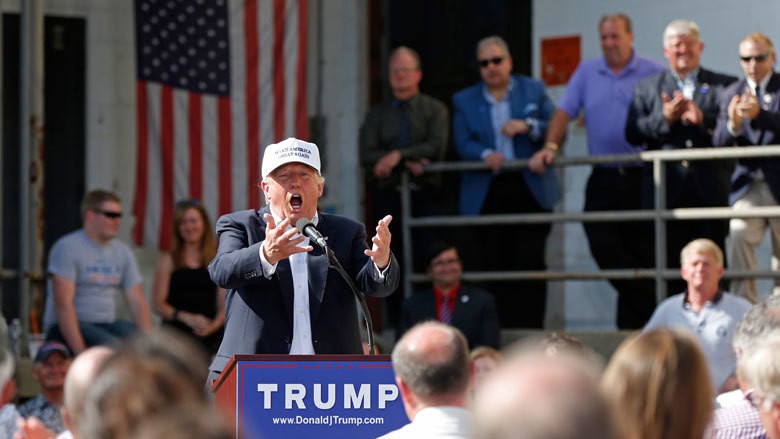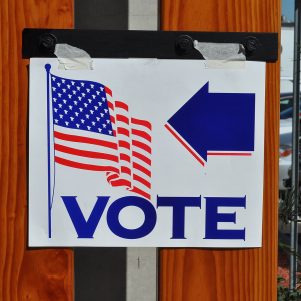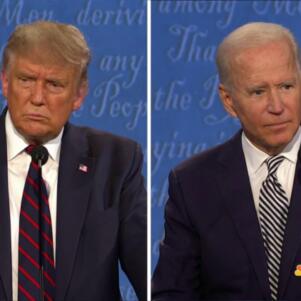Maine joins New Hampshire as presidential battleground
By Stephen Beale | October 29, 2016, 12:39 EDT
 Republican presidential candidate Donald Trump speaks at a town hall-style campaign event at the former Osram Sylvania light bulb factory, Thursday, June 30, 2016, in Manchester, N.H. (AP Photo/Robert F. Bukaty)
Republican presidential candidate Donald Trump speaks at a town hall-style campaign event at the former Osram Sylvania light bulb factory, Thursday, June 30, 2016, in Manchester, N.H. (AP Photo/Robert F. Bukaty) It’s not just New Hampshire anymore.
This presidential election year, Maine joins the Granite State as a New England battleground. Ordinarily, Maine is solidly blue. Not so in 2016.
Maine is one of two states that allow a presidential candidate to capture an electoral vote without actually winning the state. (The other is Nebraska.) Since 1972, Maine has allotted two electoral votes to the winner of the popular vote in the state as a whole. Then, the winner of the vote in each of its two Congressional districts also gets one electoral vote per district.
This system creates the hypothetical possibility that one candidate could win the state and one of its Congressional districts while the other walks away with the popular vote and one electoral vote in the other district.
“This has almost never mattered—but this year it might. If things get really close,” CNN declared at the end of September.
“Trump’s ascendancy in Maine is largely due to his dominance in the vast northern sector of the state—but analysts say it’s also a reflection of how Maine, like many other parts of the country, has become geographically more polarized. Its northern reaches, mostly rural, tend to be far more conservative than the southern, populous part of the state,” political analyst James Pindell wrote in the Boston Globe.
RealClearPolitics, a national news site that aggregates data and news on the election, ranks Maine’s Second Congressional District—which encompasses most of the land area in the state, including its northern reaches—as leaning towards Trump. The First District is viewed as being likely for Clinton.
The whole state—with two statewide electoral votes—is classified as Clinton-leaning by RealClearPolitics. Some have held out hope for a statewide Trump win: after an early September poll showed Trump closing in on Clinton, 39 to 42, Maine Governor Paul LePage, a Republican who has endorsed Trump, predicted his party’s nominee would walk away with the statewide electoral votes and the northern Congressional district, according to a report in Breitbart, a conservative news site (the former executive chairman of the site, Steve Bannon, was tapped to be the Trump campaign CEO in August.)
But Trump’s chance at catching Clinton may be slipping away. One of the more recent polls, conducted by the Maine People’s Resource Center in mid-October, showed Clinton regaining a solid lead, at 49 percent to 39 percent in a head-to-head match-up.
Clinton’s retains her lead over Trump when the two major third party candidates—Libertarian Gary Johnson and Green Party nominee Jill Stein—are thrown into the mix. Clinton then stands at 42 percent, Trump slips to 36 percent, Johnson has 9 percent, and Stein is in fourth place at 4 percent.
Meanwhile, in New Hampshire, Clinton is maintaining a solid lead over Trump. RealClearPolitics’ average of the most recent polls put Clinton at 45.5 percent and Trump at 40.5 percent. The impact of the third party candidates in the race barely diminishes her lead: Clinton 45.0 percent with Trump at 39.8 percent, according to the site.
Obama won New Hampshire in 2008 and 2012. Although Clinton has held onto her lead in the state, the possibility of a Trump win there is very real, according to the political data news site, FiveThirtyEight. The site noted that the Granite State is one of the few where Trump has actually outspent Clinton in advertising.
Unlike other swing states, New Hampshire actually has a lot of swing voters, according to FiveThirtyEight. That may sound counterintuitive, but other battlegrounds like Pennsylvania are considered swing states because they are so closely divided between stalwart Democrats and equally loyal Republicans.
“In New Hampshire, by contrast, there really are a lot of swing voters. In particular, there are lots of middle-class and upper-middle-class white voters who aren’t highly religious and don’t belong to one of the major parties. Those voters are often torn in their presidential vote in this and in other elections,” the site explains.
As for the rest of the New England states, a Clinton victory is expected. But not all are equally blue. The bluest of them all is Massachusetts. Polls here show Clinton is far ahead of Trump, averaging 59.7 percent to 28.7 percent. In fact, one recent poll showed that Clinton was garnering more than double the support Trump had, 65 percent to 30 percent.
Those figures assume a two-way race. When the third-party candidates are factored in, the distance between Clinton and Trump remains almost the same: she leads at 56.3 percent; he trails at 26.3 percent.
Of the remaining two New England states, Connecticut leans Clinton, 50 percent to 35 percent according to the latest Emerson poll. Rhode Island, meanwhile, is a little bluer, with a ranking as a likely Clinton state, according to RealClearPolitics. Clinton is again at 52 percent, but Trump is lower, at 32 percent, according to the most recent poll for the state. (The numbers for both states are factoring in the impact of the third party candidates.)
New England also has some good news for at least one third party candidate, Johnson. Nationally, he is polling on average at 5.2 percent. But in most of New England his numbers are higher than that.
An Emerson College poll had him at 8 percent in the Rhode Island in early September, but one month later he had dipped to 5 percent. In Connecticut, the trend is the reverse: Johnson has gone from 6 percent in a June poll to 9 percent in one last month.
And in dark blue Massachusetts, he’s averaging 6.0 percent.
In general, the farther north and more rural one goes, the better Johnson’s numbers. In New Hampshire, he’s averaging at 7.8 percent but previous polls have shown him even higher, at 10 percent and 11 percent. In Vermont—a state with a progressive reputation—he hit as high as 13 percent in September, before snapping down to a low 4 percent one month later. And in Maine he’s averaging 10.5 percent.
Overall, Stein’s numbers are also slightly above her national average of 2.0 percent. In general, she’s running in the mid-single digits in New England. Perhaps unsurprisingly, she’s doing her best in Bernie Sanders’ home state of Vermont, averaging 5 percent in the polls there. Her next best showing is in Rhode Island, where the average of the two most recent polls puts her at 4.5 percent. Her lowest level of support, a polling average of 2.5 percent, is in the Granite State.











